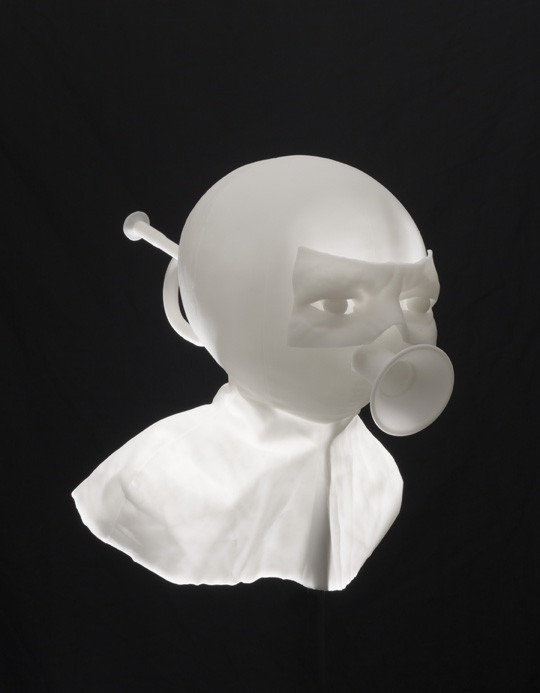Philippe Mayaux
dal 14/3/2012 al 27/4/2012
Segnalato da
14/3/2012
Philippe Mayaux
Galerie Loevenbruck, Paris
Le Destin Des Fantomes. Mayaux forces us to contemplate the priapulid worm in the apple of surrealist generescence while managing to slip the banana pulp from the skin but not swallow the pip.

A reader of the naturalist Magritte in his youth, Félix Archimède Mayaux took up the study of law, which seems to have bifurcated into anatomical science. It is important to understand that the valve installed “at the neck of the pit’s mouth” was made of thin rubber, which did not prevent a desire on his part to audaciously and idiosyncratically solve a genuine problem of applied political philosophy. Generally speaking, this is something people achieve by chopping things into segments. Today’s world is so thinly sliced that, not only can one slip through it at will but one can also skewer it here or there in slivers and fibrils, much to the pleasure of the scientists that we all are, each in our own laboratory and at our own level of research.
Thus, on the agreed day of the presentation the aforementioned Félix Archimède trumpeted, MP3-wise, in a blanched balloon. This paraffin, spread copiously over various organs which had had the delicacy to let themselves be modelled/moulded (moved as they were by their physiognomic élan), at first met with doubt, it must be admitted, on the part of the various jury members, wearing somewhat tense expressions. Pedestalled on his preachy, dictatorial, professorial or mercantile position, each harked serenely to the loop of his spiel, like a Satanist hosanna-machine. Then, suddenly realising that, as pre-biotic molecules in the lifeless ocean, they ran a serious risk of being abruptly recomposed, manu militari intuitu, these types/ideals opted for a primitive unicellular metamorphosis, thereby justifying certain premises of maieutic reasoning. Philippe Mayaux contributes his own renewed touchstone, but in real silicone, to the obsolete and hoary – and therefore very useful – theory of spontaneous generation.
Indeed, small artistic animals are, as we know, born from a pile of rags, from the ambient air outside, and leaves fall to the ground from the trees, turning into birds, just as in water they give birth to fish or idols, which are amphibians and also float, when they are not worms wriggling prettily from an appetising piece of meat, an excessively pink calf’s liver. The microbes serve as the yeast and the experimenter enjoys fiddling with his internal hypotheses, conscious and very conscious, making it a stiff task for anyone who may later want to reproduce them with the seriousness needed for dyed-in-the-wool perpetuation of the scientific.
Theories and practices accrete and adhere and, oh fatalitas, these same miniaturised major arts – history painting sculpted from gruyere, nearby a tutti frutti in the format of the Richard Fleischer’s Cold War opus Fantastic Voyage re-enacted by the Arab Spring – become all inverted. The point being that statistically these same artistic properties that should no longer be there bed still themselves in, like the memory of water (whose media moment of fame in the 1980s coincides with a new generation limbering up for battle at the Villa Arson – another surging source). Félix Archimède extracts and injects the intimate amber of this magnificent or ill-fated piece of twaddle in the Jurassic Park of his own little person, proving its point by dint of judicious mosquito bites. This is how it goes with the disputatio of the artistic fossil which soldiers on in our societies, where happily there is never any shortage of rarefied air. Is it a swindle, a controversy, the last one still possible, an insertive and receptive deep sample that would be sure to gladden the viewer and his legitimate laziness? Is it included, excluded, resonant? Excavated, underground like an energy, does it well up again, whatever one touches, assembles, sticks or adds? Is not everything mere trace, contact, tooth of civilisation – a shape-memory shell of extruded urethane or a carcinogenic blister pack or some other phtalate like the one surrounding Nutella that in the end digs into nature’s sedimentary rock? Here, the male fossil in apt alliance with the faux shill, with the hammered shadow of the symbol, forces us to re-examine the calcite of our ever more felicitous technologies of compilation and intrusion. The rancid germ was definitely there, but is it not also a poison? Mayaux forces us to contemplate the priapulid worm in the apple of surrealist generescence while managing to slip the banana pulp from the skin but not swallow the pip. No problems or scruples here, for art, however brief the links it liaises with, holds within its molecule-ordered webs a nanosecond of a fraction, whereas, marvellously strange, its objects are set hard, hard, hard (or soft, soft, soft).
JM. Writer
Image: Philippe Mayaux
Les fantômes de l’autorité, 2012
3D image, brass, wood, MP3
76 3/4 x 9 3/4 x 9 3/4 in
Photo Fabrice Gousset
© ADAGP, 2012. Courtesy galerie Loevenbruk, Paris
Contact presse :
Alexandra Schillinger, alexandra@loevenbruck.com, t 01 82 28 38 22,
assistée de Clio Lavau, factory@loevenbruck.com
Private view Thursday 15 March 2012, 6-10 pm
Galerie Loevenbruck
6, rue Jacques Callot - Paris



